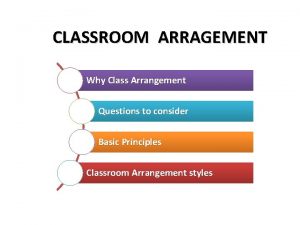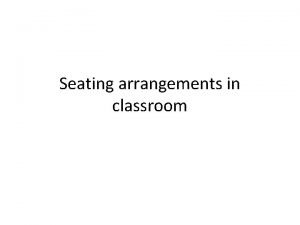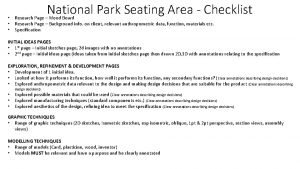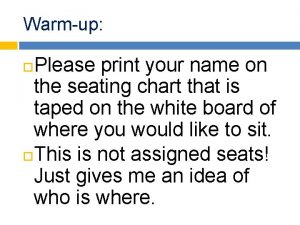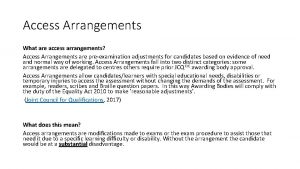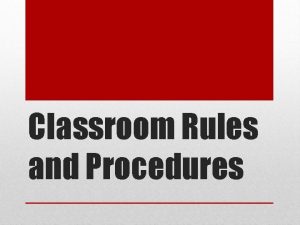The Effects of Classroom Seating Arrangements On OnTask




















- Slides: 20

The Effects of Classroom Seating Arrangements On On-Task Behavior and Academic Performance An Action Research Project By Danielle Steger EDUC 702. 22 Spring 2010

Table of Contents • Abstract • Introduction -Statement of the Problem -Review of Related Literature -Statement of the Hypothesis • Method -Participants (N) -Instruments (s) -Experimental Design -Procedure • Results • Discussion • Implications • References

Introduction Seating arrangement has been a topic of debate since the early 1900’s. Popularity has moved from single row or column seating to cluster seating, a model to encourage cooperative learning. The question still remains, what is the most effective seating arrangement for the primary classroom setting? Is there one particular model that should be used 100% of the school day, or should the lesson dictate the seating arrangement?

Statement of the Problem PS X has adopted cluster seating for all classrooms, 100% of the school day. Independent math practice at PS X is complicated by off-task behavior and would benefit from a less distracting seating arrangement, such as paired columns.

Review of Related Literature The Importance of Seating Arrangement PROS: Research Supporting Row Seating • Room arrangement affects • On-task behavior the learning process, student increases with rows. behavior, and student (Hastings & Schwieso, 1995). engagement. (Bonus & Riordan, 1998; Florman, 2003; Lackney & Jacobs, 2002; Proshansky & Wolfe, 1974; Richards, 2006; Strong-Wilson & Ellis, 2007; Susi, 1989; Weinstein, 1977).

Review of Related Literature PROS: Research Supporting Row Seating • Students prefer orderliness and clear views of the teacher. (Raviv, Raviv & Reisel, 1990). • Some learners prefer to learn alone or with one partner. (Burke & Burke-Samide, 2004; Church, 2004; Dunn & Dunn, 1975). • Learning style is 60% biological. (Dunn, 1990).

Review of Related Literature PROS: Research Supporting Row Seating • Row seating reduces talking. (Koneya, 1976; Ridling, 1994; Silverstein & Stang, 1976; Wannarka & Ruhl, 2008; Weinstein, 1979). • In the 1900’s the business model entered the American education system based on the German model of efficiency. (Callehan, 1962).

Review of Related Literature PROS: Problems With Cluster Seating • Increased proximity increases likelihood of off-task conversations. (Koneya, 1976; Ridling, 1994; Weinstein, 1979). PROS: Theorists and Supporters of Row Seating • Students prefer row seating. (Mc. Corskey & MCVetta, 1978). • Task orientation is improved. (Raviv, Raviv & Reisel, 1990; Weinstein, 1979).

Review of Related Literature CONS: Arguments Supporting Cluster Seating • It is ideal for socially facilitated learning. (Patton, Snell, Knight & Florman, 2001). • It promotes “innovation. ” (Raviv, Raviv & Reisel, 1990). • Students like each other more and communicate better when facing each other. (O’Hare, 1998; Bovard, 1951). CONS: Arguments Against Row Seating • Row seating impedes a teacher’s ability to walk between student desks and assess learning. (Weaver Dunne, 2001).

Statement of the Hypothesis HR 1: Changing the seating arrangement from cluster seating to paired columns over a five week period will increase the on-task behavior of 25 common branch second grade students at PS X during math class, and lead to increased scores on math assessments.

Method Participants Class B Class A • 2 nd Grade • Began with 24 students (12 boys, 12 girls) • Ended with 25 (12 boys, 13 girls) • PS X, Brooklyn • Common Branch • Title 1 school • Cluster Seating • 24 students (14 boys, 10 girls)

Instruments Method Student Surveys Unit Tests (en. Vision program) • Class A Pre-test • Class B Pre-test • Class A Post-test • Unit Tests 1 -11 (Pre-test) • Unit Tests 12 -14 (Post-test)

Research Design Quasi Experimental: Nonequivalent Control Group Design. • Two groups: Designated treatment group (X 1) and control group (X 2) are pre-tested (O), exposed to a treatment (X), and post-tested (O). • Symbolic Design: O X 1 O O X 2 O • Groups not randomly assigned.

Threats to Validity Internal Threats External Threats • • Generalizable Conditions • Pre-Test Treatment Selection • Treatment Interaction • Specificity of Variables • Multiple Treatments History Maturation Testing Instrumentation Selection Mortality Selection-Maturation Interaction

Procedure September 2009 – January 2010 • Pretest Data Collection (Unit Tests 1 -11) February 2010 • Class A Pre-test Survey • Class B Pre-test Survey February 2010 – March 2010 • Intervention in Class A • Post-test Data Collection (Unit Tests 12 -14) March 2010 • Class A Post-test Survey

Class A Post-test *No correlation was found. *rxy = +0. 57 Results

Results Class A & B Pre-test * Class A average 85%, Class B average 86%. * Class B performed 1% higher than Class A.

Results Class A & B Post-test * Class A average 80%, Class B average 79%. * Class A performed 1% higher than Class B.

Discussion • Theorists link seating arrangement with a child’s ability to remain attentive, work productively, and learn. (Bonus & Riordan, 1998; Burke & Burke-Samide, 2004; Koneya, 1976; Lackney & Jacobs, 2002; Mc. Corskey & Mc. Vetta, 1978; Proshansky & Wolfe, 1974; Richards, 2006; Strong-Wilson & Ellis, 2007; Susi, 1989; Weinstein, 1979). • The results support the research: - Class A and B were taught using identical lesson plans, resources, and assessments. - Pre-test: Class B outperformed Class A. - Post-test: Class A outperformed Class B.

Implications • A change in seating improved test scores in Class B. • More research needs to be done. • More participants are needed. • A longer study needs to be done.
 Circular arrangement questions
Circular arrangement questions What is seating arrangement in classroom
What is seating arrangement in classroom Reactive effects of experimental arrangements
Reactive effects of experimental arrangements Btech smart classes
Btech smart classes Skyward login kent
Skyward login kent Eps geofoam specifications
Eps geofoam specifications Fresno state v meaning
Fresno state v meaning Park seating ideas
Park seating ideas Tide fsa
Tide fsa Kprep seating chart
Kprep seating chart Hlsr seating chart
Hlsr seating chart Nia seating
Nia seating Bariatric sorrento chair
Bariatric sorrento chair Atiquette
Atiquette Irwin seating dealers
Irwin seating dealers Vue vip seats worth it
Vue vip seats worth it Learning outcomes of empathy
Learning outcomes of empathy Kprep tam
Kprep tam Pbis flow chart
Pbis flow chart Enemy corner seating arrangement
Enemy corner seating arrangement Sit on it seating torsa
Sit on it seating torsa
